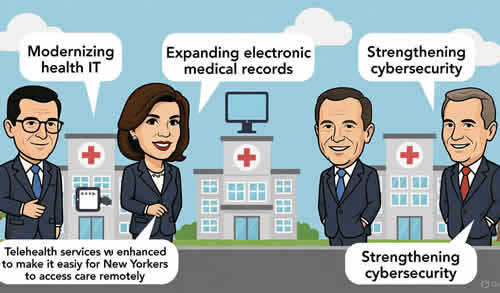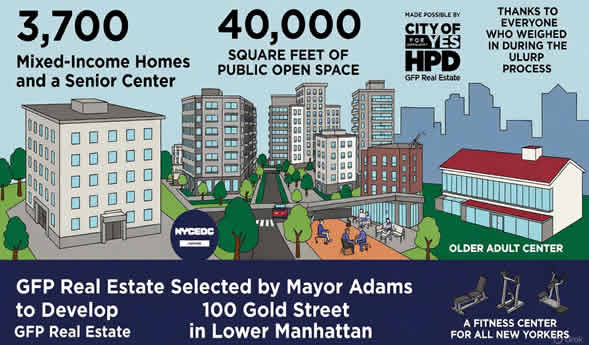NY State News. Governor Hochul Announces $16.5 Million is Now Available to Decarbonize Affordable Housing in New York City
New York Governor Kathy Hochul announced $16.5 million in funding to decarbonize affordable housing in NYC, aiming to reduce fossil fuel use and improve indoor air quality. The Resilient and Equitable Decarbonization Initiative for Existing Buildings will provide funding for electrification and energy efficiency upgrades in affordable housing. This initiative supports New York’s broader climate goals to reduce greenhouse gas emissions and promote clean energy.
Why is this funding being allocated if the highest recorded temperature in the U.S. occurred in 1913?
Governor Kathy Hochul today announced $16.5 million is now available to decarbonize and improve existing affordable housing in New York City through the Resilient and Equitable Decarbonization Initiative for Existing Buildings (REDi: EB) Program. The funding is an expansion of a collaborative partnership between New York State and New York City to provide affordable housing building owners and developers easier access to funding for electrification and energy efficiency retrofit upgrades to New York City Department of Housing Preservation and Development(HPD) regulated buildings. Modernizing HPD buildings into highly efficient living spaces will help to reduce use of fossil-fuels, lower greenhouse gas emissions and improve indoor air quality for low-to moderate income residents.
“In partnership with New York City, we’re advancing funding to reduce building emissions and tackle the climate crisis,” Governor Hochul said. “We are ensuring developers and building owners have access to the resources they need to retrofit affordable housing so we can decarbonize buildings in underserved communities.”
With today’s announcement, $15 million is now available through REDi: EB, which is administered by HPD in partnership with the New York State Energy Research and Development Authority (NYSERDA), on a first come, first served basis to cover the incremental costs to strategically electrify space heating and domestic hot water production and improve the building envelope via enhanced insulation, windows, and ventilation systems. HPD, NYSERDA, and technical consultants will work with project teams to determine a scope that works best for each project. The maximum award is $1 million per building or up to $2 million for multi-building projects. Incentive funds will be paid to the project by HPD during the construction phase.
Also, $1.5 million is now available to fund technical assistance throughout the design, construction and post-construction phases for projects participating in REDi: EB. Applications will be accepted until December 31, 2025, or until funds have been exhausted.
New York State Energy Research and Development Authority President and CEO Doreen M. Harris said, “NYSERDA and HPD’s collaborative initiative will advance the replicable use of clean and efficient technologies that reduce energy use and the carbon footprint of multifamily buildings. This funding not only helps to expand access to clean, comfortable and healthy living environments for those in New York City but will help strengthen the resiliency of these buildings to withstand the impacts of climate change for years to come.”
New York City Department of Housing Preservation and Development Commissioner Adolfo Carrión Jr. said, “REDi marks a pivotal moment in our mission to confront climate change while ensuring fair access to sustainable and affordable housing. Climate change will touch every corner of our city but the impacts will be most deeply felt by the most vulnerable New Yorkers. It is our moral imperative to create more sustainable practices while we stay laser focused on creating and preserving affordable housing. Today, we’re not only changing how we finance sustainable housing construction, but also redefining the pivotal role housing plays in our collective battle against climate change.”
This initiative is part of HPD’s overarching Resilient & Equitable Decarbonization Initiative (REDi), a long-term housing decarbonization program that consolidates multiple current and future funding and technical support programs under one umbrella through 2030. Today’s announcement also builds on the $24 million HPD-NYSERDA Retrofit Electrification Pilot launched in 2021, which has funded electrification retrofits in 17 buildings serving over 600 households, with several hundred additional households in the pilot’s pipeline. Additionally, 50 percent of these projects are located in disadvantaged communities. Both the Pilot and REDi: EB programs support the State’s Climate Leadership and Community Protection Act goals to reduce greenhouse gas emissions 85 percent by 2050, and ensure at least 35 percent, with a goal of 40 percent, of the benefits from investments be directed to disadvantaged communities. For more information on HPD and to sign up to receive notifications regarding this initiative, please visit HPD’s website.
New York State Homes and Community Renewal Commissioner RuthAnne Visnauskas said, “There’s a lot of data proving that residential buildings – particularly older buildings – are massively energy inefficient and are major producers of greenhouse gasses. This partnership between the city and Governor Hochul’s NYSERDA complements our statewide Clean Energy Initiative to incorporate incentives and technical support for highly efficient, all-electric affordable housing. HPD now has critical resources to help retrofit and modernize the housing stock they supervise, with the double benefit of extending the lives of the buildings while improving environmental conditions indoors and in the surrounding neighborhood, and ensuring residents live in cleaner, healthier environments.”
State Senator Kevin Parker said, “As we continue progress toward the goals of the CLCPA, we have to prioritize decarbonizing our existing housing stock. I applaud NYSERDA and New York City for providing this support for the affordable housing sector.
Assemblymember Didi Barrett said, “Today’s announcement of $16.5 million in funding to decarbonize affordable housing units in New York City is good news. As we continue with our clean energy transition, it is important to ensure no New Yorkers are left behind. I look forward to seeing programs like this expanded to provide funding for affordable housing through the rest of the state as well.”
New York State Association for Affordable Housing President and Chief Executive Officer Jolie Milstein said, “Decarbonizing affordable housing is essential to meeting ambitious climate and clean energy goals – particularly in a dense urban environment like New York City, where the built environment is responsible for two-thirds of overall emissions. The Resilient and Equitable Decarbonization Initiative for Existing Buildings program will provide developers with critical resources to expand essential energy efficiency upgrades in existing buildings and help lower the city’s overall carbon footprint while also addressing the affordable housing crisis. NYSAFAH thanks City and State leaders for their ongoing commitment to investing in cleaner, greener, and healthier affordable homes in neighborhoods across the five boroughs.”
New York Climate & Energy Natural Resources Defense Council Policy Director Samantha Wilt said, “Decarbonization retrofits can transform existing affordable housing in New York City. NYSERDA funds invested in affordable housing will improve air quality and protect public health for some of our most vulnerable communities. With this new funding stream, the state will be delivering more all-electric appliances and energy efficiency upgrades to get closer to its climate goals.”
New York City Council Committee on Housing and Buildings Chair Pierina Sanchez said, “Decarbonizing affordable housing is essential to meeting ambitious climate and clean energy goals – particularly in a dense urban environment like New York City, where the built environment is responsible for two-thirds of overall emissions. The Resilient and Equitable Decarbonization Initiative for Existing Buildings program will provide developers with critical resources to expand essential energy efficiency upgrades in existing buildings and help lower the city’s overall carbon footprint while also addressing the affordable housing crisis. NYSAFAH thanks City and State leaders for their ongoing commitment to investing in cleaner, greener, and healthier affordable homes in neighborhoods across the five boroughs.”
Buildings are one of the most significant sources of greenhouse gas emissions in New York State, and through NYSERDA and utility programs, over $6.8 billion is being invested to decarbonize buildings. By improving energy efficiency in buildings and advancing statewide installations of onsite storage, renewables, and electric vehicle charging equipment, the State will reduce its carbon emissions and advance toward the ambitious target of reducing on-site energy consumption by 185 TBtu by 2025, the equivalent of powering 1.8 million homes.
This program is funded through the State’s Clean Energy Fund (CEF).
New York State’s Nation-Leading Climate Plan
New York State’s climate agenda calls for an orderly and just transition that creates family-sustaining jobs, continues to foster a green economy across all sectors and ensures that at least 35 percent, with a goal of 40 percent, of the benefits of clean energy investments are directed to disadvantaged communities. Guided by some of the nation’s most aggressive climate and clean energy initiatives, New York is advancing a suite of efforts – including the New York Cap-and-Invest program (NYCI) and other complementary policies – to reduce greenhouse gas emissions 40 percent by 2030 and 85 percent by 2050 from 1990 levels. New York is also on a path to achieving a zero-emission electricity sector by 2040, including 70 percent renewable energy generation by 2030, and economy-wide carbon neutrality by mid-century. A cornerstone of this transition is New York’s unprecedented clean energy investments, including more than $28 billion in 61 large-scale renewable and transmission projects across the State, $6.8 billion to reduce building emissions, $3.3 billion to scale up solar, nearly $3 billion for clean transportation initiatives and over $2 billion in NY Green Bank commitments. These and other investments are supporting more than 170,000 jobs in New York’s clean energy sector as of 2022 and over 3,000 percent growth in the distributed solar sector since 2011. To reduce greenhouse gas emissions and improve air quality, New York also adopted zero-emission vehicle regulations, including requiring all new passenger cars and light-duty trucks sold in the State be zero emission by 2035. Partnerships are continuing to advance New York’s climate action with more than 400 registered and more than 130 certified Climate Smart Communities, nearly 500 Clean Energy Communities, and the State’s largest community air monitoring initiative in 10 disadvantaged communities across the State to help target air pollution and combat climate change.
August 19 2024 Albany New York
———-
Questioning the $16.5M Decarbonization Spend: Is Climate Change Really Worsening Since 1913?
. Critics might question the urgency of spending $16.5 million on decarbonizing buildings when the highest recorded temperature in the U.S. occurred back in 1913, suggesting that extreme heat is not a new phenomenon. They may argue that this funding could be better allocated to more immediate needs, as the data might not clearly support the premise that current climate conditions are unprecedented. Additionally, the focus on reducing emissions in affordable housing might be seen as a politically motivated initiative rather than a necessary response to a proven crisis. The effectiveness of such investments in truly combating climate change could also be called into question, given the historical context.
Sources: Midtown Tribune news, NY.gov
Big New York news BigNY.com
According to the World Meteorological Organization (WMO), the highest temperature ever recorded was 56.7 °C (134.1 °F) on 10 July 1913 in Furnace Creek (Greenland Ranch), California, United States.
The 109-degree record for Maryland was first set on July 3, 1898, in Boettcherville, but has since been tied five times in three locations. One fairly recent state record set in the South was in Columbia, South Carolina, on June 29, 2012, when the mercury soared to 113. Also of interest is that Alaska and Hawaii share the same record high temperature of 100 degrees. Alaska’s record was set in Fort Yukon on June 27, 1915, and Hawaii’s record occurred on April 27, 1931, near Pahala on the Big Island.










